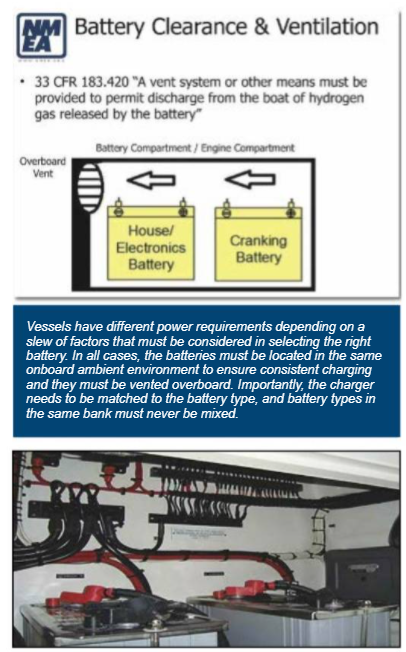Battery chargers are on almost every boat so lets take a look at some of the requirements and limit this discussion to lead acid batteries – not lithium-ion batteries. Lead acid batteries come in three types: wet cell, gel cell, and AGM(Absorbed Glass Mat). Since batteries are used on so many boats and for many tasks, their application is not always intuitive. Lead acid batteries have been around for a long time – they were invented by Gaston Plant in 1859…For years, the wet cell was all we had. Consisting of a lead plate and a lead dioxide plate submersed in sulfuric acid, it turns out that Mother Nature gives us a 1.6-volt potential across a single cell. The basic chemistry of the voltaic cell is the same for gel cell and AGM batteries. Like all marine electronics and boating, we take what Mother Nature gives us and harness it. Manufacturers have figured out how to make electrolyte jelly and also how to absorb the electrolyte into a fiberglass mat, and these changes matter to our installation and application.
Location, Location, Location
When lead acid batteries charge, hydrogen gas is emitted. This very common gas is part of air and is generally harmless if dispersed. Lighter than air, most boaters don’t worry about hydrogen gas from their batteries, but they should! Hydrogen gas is very explosive if concentrated, so sealed battery boxes must be vented overboard! Batteries in unsealed boxes or mounted in free air still present a challenge. Since the hydrogen gasses rise from the battery and tend to hang around until ventilated, a corrosive atmosphere can form above the batteries. This is why we never mount the charger directly above the batteries.

Some things are true of all batteries, like when they are warm they accept and give up a charge faster than when they are cool. This is why the NMEA Marine Electronics Installer training states that, “Batteries of the same bank shall be located in the same ambient environment.” If one battery is in the engine room and one in the cabin, charging will be adversely affected – tending to overcharge the warm one or undercharge the cool one. Both conditions lead to early battery failure.
A Good Match
There are differences between the three types of lead acid batteries. Wet cells, gel cells, and AGM batteries each have their own electrical characteristics. The battery charger must be matched to the battery type in use. This is true whether it’s an alternator, solar, wind or tide powered charger because all are hooked to lead acid batteries. Alternators and other types of chargers need to be regulated so that they match the battery type. Some alternators have internal regulators, some have external. Solar and wind chargers typically have external regulators. These regulator devices throttle the output of the charger to ensure a proper charge.
Modern dockside powered battery chargers have a selector to match the hcarger to the battery type. This is critical for proper charging and battery life. This also means that we never mix battery types in the same bank. As technology advances, manufacturers change the requirements for their batteries as they evolve. Always follow manufacturers specifications for charging requirements.
Some Considerations
Vessels of different types have very different battery requirements. We always consider the loads and requirements for the vessel when underway, docked, anchored, or in an emergency. Sizing batteries and chargers is beyond the scope of this article, but here are a few things to think about. It is easy to tell if your battery will crank a motor, but how long will it run a refrigerator? When a battery is low, it charges(accepts a charge) quickly and slows down as it approaches a full-charge condition. Stone cold dead batteries are usually damaged. Never us a two-prong hardware store charger on a boat – you have a 50/50 chance of electrocuting someone.
Batteries and battery chargers are one of the places where American Boat & Yacht Council and NMEA overlap. Since marine electronics depend on batteries, technicians and installers are often asked to upgrade batter setups. NMEA recommends installing a dedicated electronics battery bank on boats with only one starting battery. The ABYC section E-10 is the published standard for battery and charger installations on small craft. This overlap and many others is why NMEA and ABYC have partnered to offer the combined ABYC/NMEA training classes where candidates can acquire the NMEA MEI, NMEA 2000* Installer and ABYC electrical training in one week.